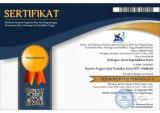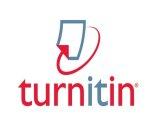Development of SAVI-Based Basic Chemical Law E -Module
DOI:
https://doi.org/10.33394/hjkk.v13i5.15124Keywords:
E -Module, SAVI, Basic Laws of Chemistry.Abstract
The purpose of this study was to determine the validity of the SAVI-based basic chemical law e-module and to determine students' responses to the SAVI-based basic chemical law e-module. This study was conducted at SMA Negeri 5 Pontianak, Class XI Chemistry Major. This type of research is Research & Development (R&D), using the ADDIE development model (analysis, design, development, implementation, evaluation) with limitations on the development stage. The results of the study indicate that the developed SAVI-based basic chemical law e-module is included in the very feasible and feasible category with validation results from material experts of 97% (Very Valid), validation from language experts of 100% (Very Valid), validation from media experts of 96.13% (Very Valid), the results of the limited response test conducted by 12 students in class XI Chemistry majoring in three assessment aspects are categorized as very good with details of the module display aspect of 93.75% (Very Good), the material presentation aspect of 93.22% (Very Good), and the benefit aspect of 93.22% (Very Good), and the results of the extensive response test conducted by 24 students in class XI Chemistry majoring in the module display aspect showed a score of 93% (Very Good), the material presentation aspect of 93.48%, and the benefit aspect of 94.53% (Very Good). This shows that the SAVI-based basic chemical law e-module is very feasible to use in the learning process.
References
Alwanuddin, A., Hairida, H., Ulfah, M., Enawaty, E., & Rasmawan, R. (2022). Pengembangan Modul Elektronik Berbasis SAVI pada Materi Bentuk Molekul. Edukatif : Jurnal Ilmu Pendidikan, 4(3), 4856–4873. https://doi.org/10.31004/edukatif.v4i3.2994
Alwi, I. (2012). Kriteria Empirik Dalam Menentukan Ukuran Sampel. Jurnal Formatif, 2(2), 140–148.
Aprima, D. (2022). Cendikia : Media Jurnal Ilmiah Pendidikan Analisis Penerapan Pembelajaran Berdiferensiasi Dalam Implementasi Kurikulum Merdeka Pada Pelajaran Matematika SD. Media Jurnal Ilmiah Pendidikan, 13(1), 95–101.
Ardistya Puspita Sari, & Indra Martha Rusmana. (2021). Pengembangan Media Pembelajaran Berbasis Videoscribe Sparkol Pada Materi Kekongruenan Dan Kesebangunan Di Smp Pgri 2 Bogor. Jurnal Lebesgue : Jurnal Ilmiah Pendidikan Matematika, Matematika Dan Statistika, 2(1), 112–120. https://doi.org/10.46306/lb.v2i1.29
Enawaty, E., Studi, P., Kimia, P., & Tanjungpura, U. (2021). Pengembangan Petunjuk Praktikum Penetuan Trayek pH Dengan Indikator Alami Berbasis Kearifan Lokal. 9(4), 110–116.
Faiz, A., Pratama, A., & Kurniawaty, I. (2022). Pembelajaran Berdiferensiasi dalam Program Guru Penggerak pada Modul 2.1. Jurnal Basicedu, 6(2), 2846–2853. https://jbasic.org/index.php/basicedu
Gusteti, M. U., & Neviyarni. (2022). Pembelajaran Berdiferensiasi Pada Pembelajaran Matematika Di Kurikulum Merdeka. Jurnal Ilmiah Pendidikan Matematika, Matematika Dan Statistika, 3(3), 636–646. https://doi.org/10.4324/9781003175735-15
Hanum, L., Ismayani, A., & Rahmi, R. (2017). Pengembangan Media Pembelajaran Buletin Pada Materi Hukum-Hukum Dasar Kimia. Jurnal IPA Dan Pembelajaran IPA (JIPI), 1(1), 42–48.
Husna, F. E., & Aini, F. Q. (2023). Perbedaan Hasil Belajar Siswa Antara Pembelajaran Berdiferensiasi Proses Berdasarkan Kesiapan Belajar dengan Berdasarkan Gaya Belajar Pada Materi Ikatan Kimia. 7, 14189–14196.
Monica, I., Nurhamidah, & Elvinawati. (2023). Pengembangan E- LKPD Berbasis Problem Based Learning Pada Materi Hukum-Hukum Dasar Kimia. Jurnal Pendidikan Dan Ilmu Kimia, 7(1), 33–43.
Mumpuni, A., & Nurbaeti, R. U. (2019). Analisa Faktor Yang Mempengaruhi Minat Baca Mahasiswa PGSD. Jurnal Riset Pedagogik, 3(2), 123–132. https://doi.org/10.33373/dms.v11i2.4060
Nalarita, Y., & Listiawan, T. (2019). Pengembangan E-Modul Kontekstual Interaktif Berbasis Web pada Mata Pelajaran Kimia Senyawa Hidrokarbon Yulia. Jurnal Ilmiah Multitek Indonesia, 12(2), 85–94.
Nuraeni, W., Kurnianti, E., & Hasanah, U. (2023). Analisis Penggunaan Video Animasi Sebagai Media Pembelajaran Terpadu Terhadap Motivasi Belajar Siswa Sekolah Dasar. Jurnal Genta Mulia, 14(2), 81–95. https://doi.org/10.61290/gm.v14i2.415
Nurul, H., Baidowi, Amrullah, & Junaidi. (2019). Peningkatan Profesionalisme Guru Melalui Lesson Study Berbantuan Media Pembelajaran Di MTs Darul Qur’an Bengkel. Jurnal Pendidikan Dan Pengabdian Masyarakat, 2(2), 325–327.
Padmanaba, I. K. G., Kirna, I. M., & Sudria, I. B. N. (2018). Pengembangan Media Pembelajaran Iteraktif Kimia Koloid Berbantuan Komputer Untuk Siswa SMA. Jurnal Pendidikan Kimia Indonesia, 2, 1–10.
Panjaitan*, R. G. P., Titin, T., & Wahyuni, E. S. (2021). Kelayakan Booklet Inventarisasi Tumbuhan Berkhasiat Obat sebagai Media Pembelajaran. Jurnal Pendidikan Sains Indonesia, 9(1), 11–21. https://doi.org/10.24815/jpsi.v9i1.17966
Permani, A. (2019). Pengembangan Modul Elektronik Pemrograman Berorientasi Objek untuk Siswa Kelas XI Rekayasa Perangkat Lunak dengan Model Four-D. 4(May), 12–16. https://doi.org/10.21831/elinvo.v4i1.28260
Purwanto, Y., & Rizki, S. (2015). Pengembangan Bahan Ajar Berbasis Kontekstual Pada Materi Himpunan Berbantu Video Pembelajaran. AKSIOMA Journal of Mathematics Education, 4(1), 67–77. https://doi.org/10.24127/ajpm.v4i1.95
Rama, A., Putra, R. R., Huda, Y., & Lapisa, R. (2022). Pengembangan E-Modul Menggunakan Aplikasi Flip PDF Profesional Pada Mata Kuliah Analisis Kurikulum Pendidikan Dasar. 7(1), 42–47.
Ridwan, A., Masriani, M., Sartika, R. P., Hairida, H., & Muharini, R. (2022). Development of Biochemical Practice Guide Website Based on Guided Inquiry on Amilum Identification Materials. EduChemia (Jurnal Kimia Dan Pendidikan), 7(1), 56. https://doi.org/10.30870/educhemia.v7i1.12607
Ristiyani, E., Kimia, P., Islam, U., Syarif, N., & Jakarta, H. (2016). Analisis Kesulitan Belajar Kimia Siswa Di SMAN X Kota Tanggerang Selatan. Jurnal Penelitian Dan Pembelajaran IPA, 2(1), 18–29. https://jbasic.org/index.php/basicedu
Sugiono. (2016). Metode Penelitian Kuantitatif, Kualitatif dan R&D (Issue April).
Umbara, U. (2017). Implikasi Teori Belajar Konstruktivisme Dalam Pembelajaran Matematika. Jurnal Matematika Ilmiah STKIP Muhammadiyah Kuningan, 3(1).
Veriansyah, I. (2022). Pengaruh Penerapan Model Pembelajaran SAVI Terhadap Hasil Belajar Siswa Di Kelas X SMAN 6 Pontianak. Jurnal Pendidikan Ilmu Pengetahuan Sosial Indonesia, 7, 71–80.
Wahyuningsari, D., Mujiwati, Y., Hilmiyah, L., Kusumawardani, F., & Sari, I. P. (2022). Pembelajaran Berdiferensiasi Dalam Rangka Mewujudkan Merdeka Belajar. Jurnal Jendela Pendidikan, 2(04), 529–535.
Published
How to Cite
Issue
Section
Citation Check
License
License and Publishing Agreement
In submitting the manuscript to the journal, the authors certify that:
- They are authorized by their co-authors to enter into these arrangements.
- The work described has not been formally published before, except in the form of an abstract or as part of a published lecture, review, thesis, or overlay journal.
- That it is not under consideration for publication elsewhere,
- That its publication has been approved by all the author(s) and by the responsible authorities – tacitly or explicitly – of the institutes where the work has been carried out.
- They secure the right to reproduce any material that has already been published or copyrighted elsewhere.
- They agree to the following license and publishing agreement.
Copyright
Authors who publish with Hydrogen: Jurnal Kependidikan Kimia agree to the following terms:
- Authors retain copyright and grant the journal right of first publication with the work simultaneously licensed under a Creative Commons Attribution License (CC BY-SA 4.0) that allows others to share the work with an acknowledgment of the work's authorship and initial publication in this journal.Â
- Authors are able to enter into separate, additional contractual arrangements for the non-exclusive distribution of the journal's published version of the work (e.g., post it to an institutional repository or publish it in a book), with an acknowledgment of its initial publication in this journal.
- Authors are permitted and encouraged to post their work online (e.g., in institutional repositories or on their website) prior to and during the submission process, as it can lead to productive exchanges, as well as earlier and greater citation of published work.
Licensing for Data Publication
Hydrogen: Jurnal Kependidikan Kimia uses a variety of waivers and licenses, that are specifically designed for and appropriate for the treatment of data: Open Data Commons Attribution License, http://www.opendatacommons.org/licenses/by/1.0/ (default) Other data publishing licenses may be allowed as exceptions (subject to approval by the editor on a case-by-case basis) and should be justified with a written statement from the author, which will be published with the article.








